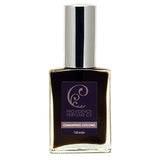
Providence Perfume Co. is an all natural perfume company.
I'm mad for Jasmine. Simply infatuated.
I can't recall the first time I smelled the lush aroma of Jasmine. I grew up in New England, a region not exactly famous for it's jasmine cultivation. I believe my first contact with Jasmine would be as a teenager working the perfume counter at Macy's. I went wild with smelling every perfume I could. I sniffed every exotic gorgeously packaged mainstream perfume I had missed out on growing up in a small rural town. The perfume counter at Macy's was glamour and glitz and sophistication. I found myself drawn to a variety of scents and they all had one note in common: jasmine.
Now I realize what I was huffing was most likely synthetic jasmine. It wasn't until I was a bit older that I actually smelled real jasmine absolute. Jasmine absolute is so incredible, so creamy and full and plump; in my opinion it's aroma is unable to be wholly duplicated by aroma chemicals. In Jean-Claude Ellena's book
Perfume, the Alchemy of Scent he comprised a pared down list of essences he uses for perfumery he calls "The Collection." The list is smaller than you might expect. I found it interesting that along with
Jasmal, Jasmolacton and
Jasmonal H (synthetic jasmines) Ellena also lists Jasmin absolute and Jasmin Sambac absolute. It's also interesting to note that Jasmine is the only aroma included in the collection in five different compilations. From this we learn that Jasmine is IMPORTANT to perfumery and that real Jasmine absolute is UNDUPLICATABLE.

Fast forward a few years and I find myself working for Aveda surrounded by real Jasmine. I was in jasmine heaven. During this time I found that jasmine possesses universal appeal. While many customers wrinkled their noses at the scent of patchouli and even rose, they smiled when sniffing the sweet aroma of jasmine. I learned my lesson well. Even now, when blending a custom scent for a more err . . . challenging client I reach for the jasmine. When all else fails, jasmine triumphs!
There is a jasmine for every preference. Sweet jasmine, musky jasmine, dirty jasmine, filthy jasmine. When teaching Introductory Natural Perfume classes, I'll often pass around a bottle of unlabeled jasmine grandiflorum for everyone to smell. When I ask the class what essence they think they're sniffing many will guess correctly it's jasmine. I'll then pass around bottles of jasmine sambac, jasmine flexile, jasmine auriculatum. Silence. Many haven't smelled these jasmines. Many are surprised that jasmine can vary so wildly in aroma. We talk of indole and jasmine. We laugh.
- Jasmine is present in many of my perfumes.
- Jamine's beauty beckons me.
- Jasmine blends well with all essences.
- Jasmine is a team player. In perfumery jasmine is happy to take a supporting role or be a star.
- Jasmine is indispensable and important.
If you have any Jasmine absolute, go grab it and take a deep long sniff. See what I mean? It's just that good.
In celebration of the Natural Perfumers Guild sixth anniversary blog event, the following perfumers are participating by sharing stories of their first love. From sandalwood to rose, be sure to check these articles out (see below.)
Visit our website to learn more about
natural perfumes or contact Charna at
providenceperfume@gmail.com.






